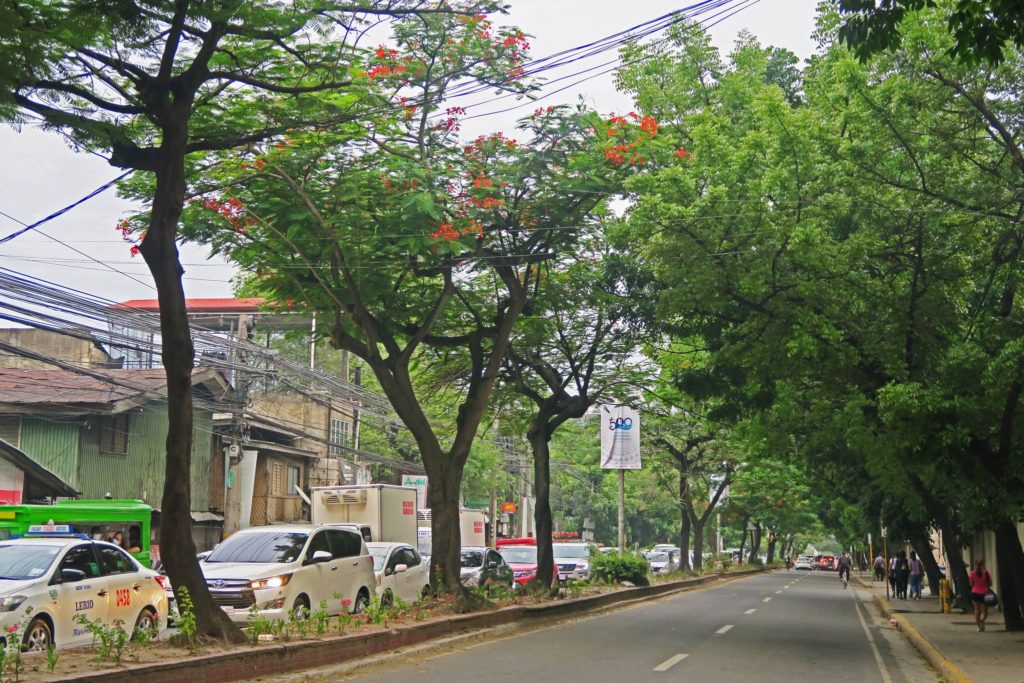Kasambagan used to have estates owned by old and wealthy families in Cebu City.
And if you look from a distance, the sight of tall “sambag” trees would catch your eyes, the reason why the barangay was called Kasambagan or an area with sambag trees.
Barangay Councilor Danilo Heramis said that sambag trees in the area grew near sugarcane plantations that were located on its estates.
To date, there are only about 10 sambag trees that can still be found in their barangay, one of the oldest of which, a century old tree, is located in Sitio Paradise 2, located at the back of Patio Isabel.
He knew of the location of these trees during his sitio visits, Heramis said.

Sambag trees on the traffic island of Pope John Paul II Ave. | Contributed Photo
A resident of Paradise 2, who is about 90-years-old, once told him that the tree has been in their community even before she was born.
“Wala namo na document gyud og asa ang location ani nga mga punoan sa sambag pero naa koy nakit-an sa akong mga pag bisita sa among mga lugar. Naa pay nahibilin pero gamay na lang gyud,” he said.
(We were unable to document the location of these trees but I have seen some of these during my sitio visits. We only have a few remaining trees.)
He said that they lost their sambag trees and even their sugarcane plantations to development. Estates were subdivided and converted into subdivisions.
Heramis, the chairperson of the barangay council’s ways and means and finance committees, said that they now have at least 12 exclusive villages in their barangay.
Starting in the late 70s and early 80s, commercial buildings also started to mushroom there.
And if you look from a distance, the sight of tall “sambag” trees would catch your eyes, the reason why the barangay was called Kasambagan or an area with sambag trees.
To date, various condotels and hotels were also constructed in their barangay to especially cater to transients who come here for business or those who are now working at call centers.
Some of those who work at the nearby Cebu Business Park and IT Park also live in condominium, condotels and rooms for rent that are located in their area.
“Pag boom sa hotels and call centers, daghan ang diri paingon namo kay daghan man ug bakante nga yuta diri,” he said.
(When hotels and call centers started to boom, many opened a business in our area because we had available land.)
The presence of businesses here and the passage of an ordinance in 2013 to tax commercial spaces is one of the reasons for their annual income of at least P15 million.
But social problems like traffic congestion is always a price to pay for development.
Heramis said that with the commercial boom in their area, Panagdait Road and Governor Cuenco Avenue that is located on the city’s northern corridor also became congested.

Bonifacio District, a lifestyle center located along Panagdait Road | Contributed Photo
“We are in a strategic location that is why we attract businesses,” he said.
Looking ahead, Heramis said that he could see more businesses opening in Kasambagan 10 years from now.
If the Cebu Business Park is the Makati City of Cebu, he likened Barangay Kasambagan to Quezon City that is also home to various small and medium scale businesses in Metro Manila.
Read more: Boy injures finger while answering modules; gets aid at Kasambagan health center
This story is part of CDN Digital’s newest series, Sa Cebu Ra Ni, where we discover interesting stories and topics thriving in the corners and nooks of our barangays in Cebu! If you have any story suggestions from Cebu City barangays, feel free to send us a message on our Facebook page – CDN Digital.

